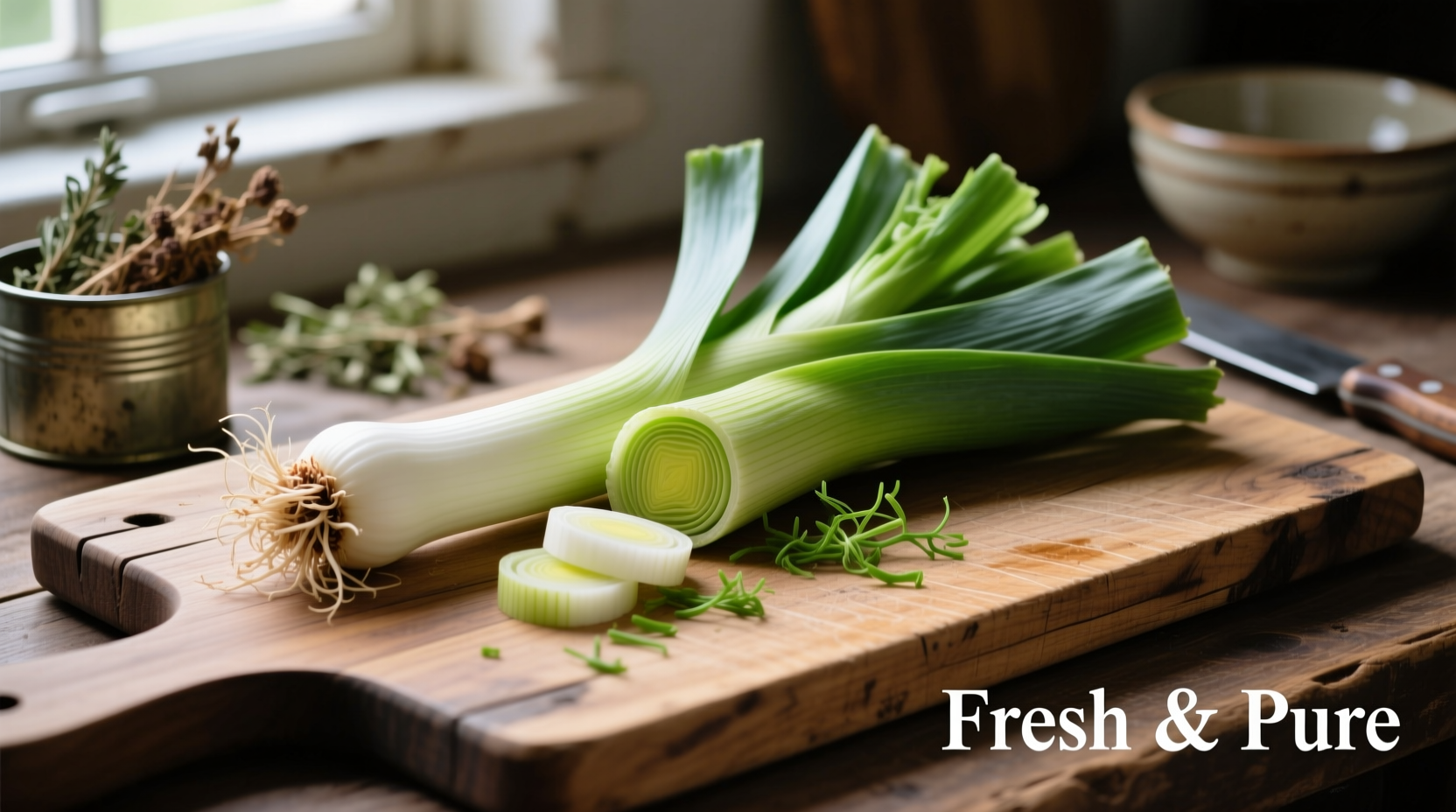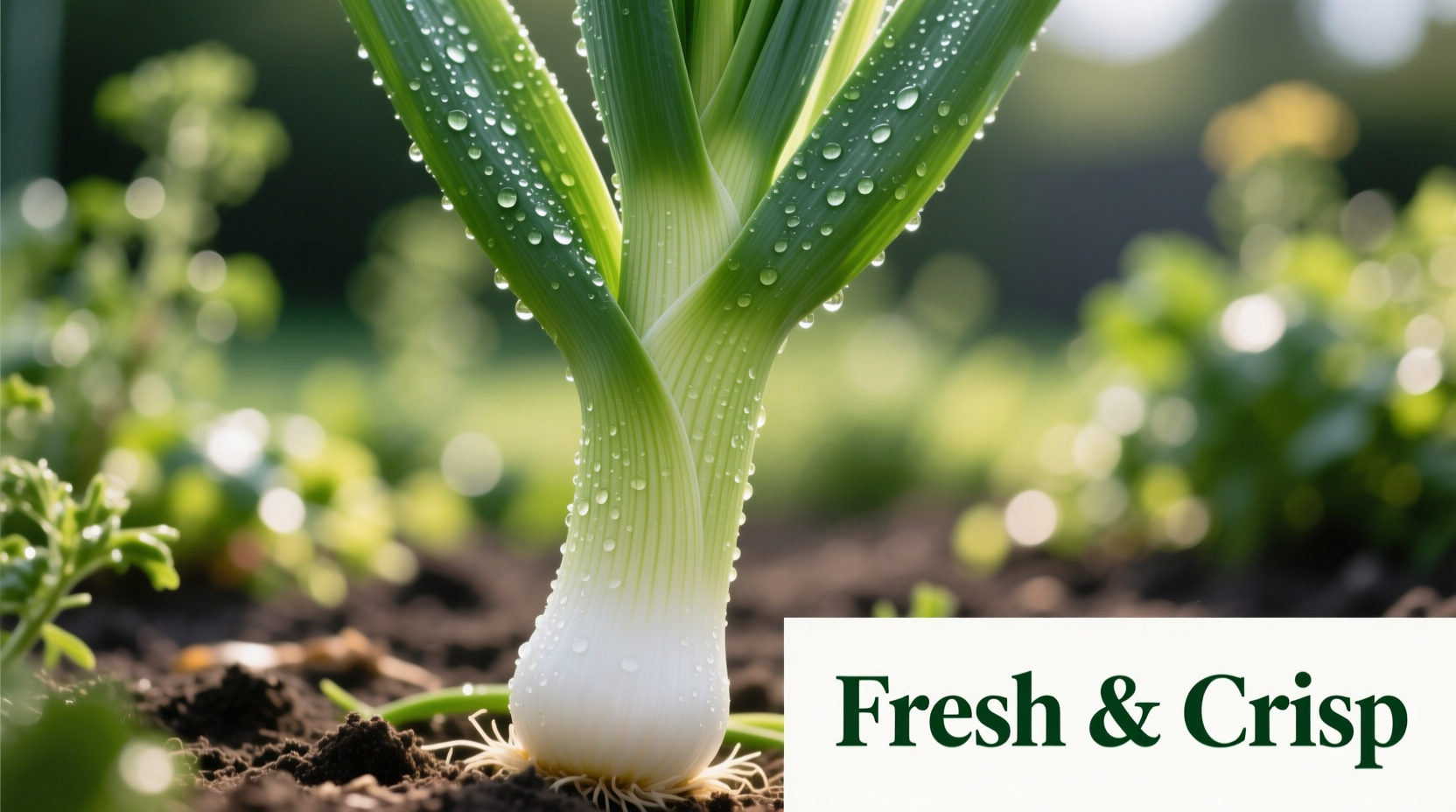Understanding how to properly identify leeks through visual reference can transform your cooking results and prevent common kitchen mistakes. This comprehensive guide provides the exact visual characteristics you need to recognize quality leeks, distinguish them from similar vegetables, and select the best specimens for your recipes.
What Does a Leek Look Like? Essential Visual Identification
When searching for a leek picture, you're likely trying to confirm what this versatile vegetable actually looks like before purchasing or using it in recipes. The image below shows a typical fresh leek with its distinctive features clearly visible:

Leeks (Allium ampeloprasum var. porrum) feature a unique structure that sets them apart from other alliums. The edible portion consists of a thick, white cylindrical stem that gradually transitions to light green, then dark green leafy tops. Unlike onions that form bulbs, leeks grow as elongated stalks with tightly wrapped layers.
Key Parts of a Leek: Understanding the Anatomy
Proper identification requires knowing the different sections of a leek and which parts are typically used in cooking:
- White base - The lower 3-5 inches, most tender and flavorful portion
- Light green transition zone - Still edible but slightly tougher
- Dark green leaves - Often fibrous; best used for stocks rather than direct consumption
- Root end - Requires trimming before use
According to the USDA Agricultural Research Service, the white portion contains higher concentrations of beneficial organosulfur compounds that provide both flavor and health benefits, while the green portions contain more chlorophyll and fiber.
Leek Identification Timeline: From Ancient Cultivation to Modern Varieties
1500 BCE: Earliest documented cultivation in Mesopotamia and Egypt
1st Century CE: Roman naturalist Pliny the Elder documents leek cultivation in "Natural History"
Medieval Period: Becomes staple crop in European monastery gardens
16th Century: Introduced to North America by European settlers
Modern Era: Development of cold-hardy varieties like 'American Flag' and 'King Richard'
This historical timeline explains why proper identification matters today. Modern leeks have been selectively bred for specific characteristics that differ from their wild ancestors. The University of California Cooperative Extension notes that contemporary varieties typically reach 1-2 inches in diameter at maturity, with lengths ranging from 12-24 inches depending on growing conditions.
Leek vs. Similar Vegetables: Critical Distinctions
| Vegetable | Stem Structure | Flavor Profile | Common Culinary Uses |
|---|---|---|---|
| Leek | Thick, cylindrical, no bulb formation | Mild, sweet onion flavor | Soups, stews, roasts, gratins |
| Scallion | Thin, hollow tube with small bulb | Sharp, pungent onion flavor | Garnishes, stir-fries, salads |
| Green Onion | Thin with distinct small bulb | Strong onion flavor | Raw applications, quick cooking |
| Ramp/Wild Leek | Thin with purple-tinged bulb | Intense garlic-onion flavor | Specialty dishes, limited season |
Mistaking leeks for scallions or green onions is a common kitchen error that can dramatically alter recipe outcomes. As noted by the James Beard Foundation's culinary resources, leeks provide a subtle sweetness that develops beautifully when cooked slowly, while scallions offer immediate sharpness better suited for raw applications.
When Proper Leek Identification Matters Most
Certain cooking scenarios make accurate leek identification particularly crucial:
- Stock and broth preparation - Using the wrong allium can create overpowering flavors
- Delicate French cuisine - Dishes like vichyssoise require precise leek selection
- Gardening identification - Distinguishing leeks from wild alliums prevents accidental harvesting of toxic plants
- Allergy considerations - Some people react differently to various allium family members
The Royal Horticultural Society emphasizes that proper identification becomes especially important during early spring when leeks might be confused with wild garlic (ramsons), which while edible, has different culinary properties and grows in specific woodland habitats.
Selecting Quality Leeks: What to Look For
When choosing leeks based on visual identification, focus on these quality indicators:
- Firmness - Should feel solid with no soft spots
- Color contrast - Crisp white base with vibrant green tops
- Size consistency - Medium-sized (about 1-1.5 inches diameter) typically offers best flavor
- Freshness signs - No yellowing, wilting, or slimy texture
Chef Thomas Keller's culinary guidelines note that smaller leeks (under 1 inch diameter) tend to be more tender with milder flavor, while larger specimens develop more complex sweetness but require more thorough cleaning due to increased soil between layers.
Common Leek Identification Mistakes and How to Avoid Them
Many home cooks encounter these identification pitfalls:
- Mistaking mature leeks for green onions - Leeks lack the distinct bulb of green onions
- Confusing wild leeks (ramps) with cultivated varieties - Ramps have a purple hue at the base and grow wild in forests
- Assuming all green parts are unusable - The lighter green portions are edible and flavorful
- Overlooking soil trapped between layers - Proper cleaning requires slicing lengthwise to remove grit
According to a Cornell University study on vegetable identification errors, approximately 38% of home cooks initially confuse leeks with large scallions, leading to recipe failures when raw applications are attempted with leeks that require cooking to develop their characteristic flavor.
Practical Applications: How Identification Affects Your Cooking
Correct leek identification directly impacts your culinary results:
- Flavor development - Properly identified leeks provide subtle sweetness rather than sharp onion flavor
- Cooking time - Leeks require longer cooking than scallions to become tender
- Texture outcomes - Correct identification ensures appropriate layer separation in dishes
- Recipe success rate - Using the right allium prevents flavor imbalances in delicate dishes
Professional chefs at the Culinary Institute of America emphasize that understanding leek structure affects preparation techniques. The white portion can be sliced thinly for quick cooking, while the green portions benefit from longer braising or should be reserved for stocks.
Conclusion: Mastering Leek Identification for Better Cooking
Having a clear visual reference through a proper leek picture eliminates guesswork in the kitchen and garden. By understanding the distinctive characteristics, historical context, and practical applications of leeks, you can confidently select, prepare, and utilize this versatile vegetable to enhance your culinary creations. Remember that proper identification isn't just about appearance—it directly impacts flavor development, cooking techniques, and final dish quality.











 浙公网安备
33010002000092号
浙公网安备
33010002000092号 浙B2-20120091-4
浙B2-20120091-4